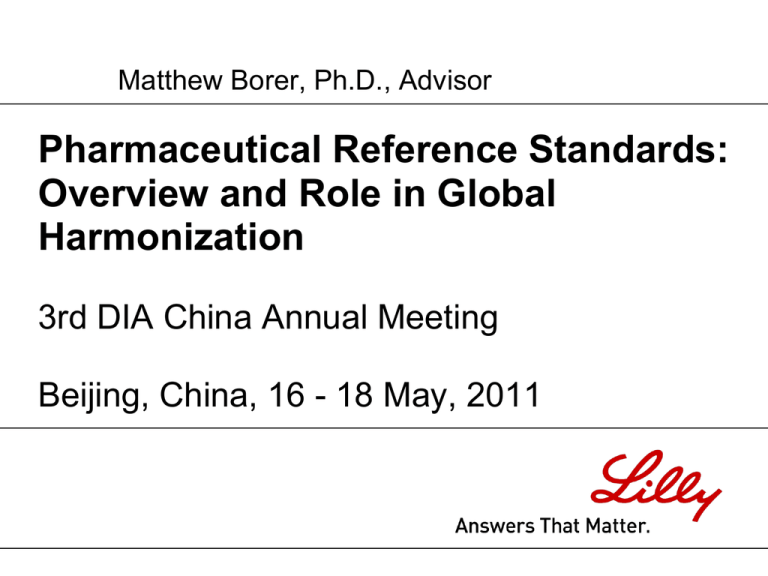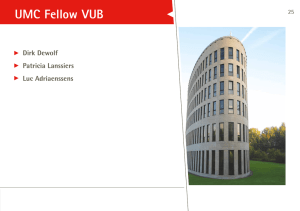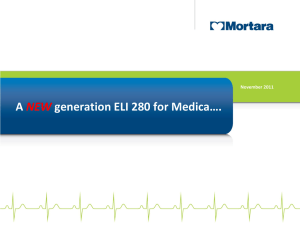Reference Standard Uses - Drug Information Association
advertisement

Matthew Borer, Ph.D., Advisor Pharmaceutical Reference Standards: Overview and Role in Global Harmonization 3rd DIA China Annual Meeting Beijing, China, 16 - 18 May, 2011 What is a Pharmaceutical Reference Standard? A highly purified sample of a particular compound that has been characterized so that an accurate content can be stated Used as the basis for quantitative and qualitative testing if 100% SAMPLE M. Borer, May 2011, 3rd DIA China Meeting Copyright © 2011 Eli Lilly and Company then 90% 2 Reference Standard Materials M. Borer, May 2011, 3rd DIA China Meeting Copyright © 2011 Eli Lilly and Company 3 Reference Standard Information Certificate Protocol M. Borer, May 2011, 3rd DIA China Meeting Data Package Copyright © 2011 Eli Lilly and Company 4 Reference Standard Uses Quantitative calibration Identity comparison Test of system suitability Peak marker Fingerprinting Visual comparison M. Borer, May 2011, 3rd DIA China Meeting Copyright © 2011 Eli Lilly and Company 5 Types of Reference Standards Reference Standard Company Laboratory-based Official Reference Standard Reference Standard Reference Standard Primary Reference Standard Primary Reference Standard Secondary Reference Standard Other Reference Standard M. Borer, May 2011, 3rd DIA China Meeting Copyright © 2011 Eli Lilly and Company 6 M. Borer, May 2011, 3rd DIA China Meeting Copyright © 2011 Eli Lilly and Company 7 The Role of Reference Standards in a Pharmaceutical Control System Reference Standards are developed as part of the analytical control strategy for each drug product Each reference standard has a control strategy of its own Reference Standards play a central role in assuring the quality of medicines for patients during cGMP testing and release activities M. Borer, May 2011, 3rd DIA China Meeting Copyright © 2011 Eli Lilly and Company 8 Simplified Product Control Strategy What the measurement means… How to measure… What to measure… Basis of the measurement… M. Borer, May 2011, 3rd DIA China Meeting Copyright © 2011 Eli Lilly and Company When to measure… 9 Reference Standard Control Strategy M. Borer, May 2011, 3rd DIA China Meeting Copyright © 2011 Eli Lilly and Company 10 Regulations Governing RS Operations Food and Drug Administration (FDA) – – – – – CFR Title 21 – Food and Drugs GMP, 211.194(c), 211.160(b)(1) and 299.5(c) ICH Guidelines Q7, Q6B Various FDA Guidance Documents FDA regulatory observations (Warning Letters, 483’s) United States Pharmacopeia European Agency for the Evaluation of Medicinal Products (EMEA) – – – – EU GMP 32, Annex 18 (transcription of ICH Q7) EU Quality Guideline 32 (regulatory submission requirements) ICH Guidelines Q7, Q6B European Pharmacopoeia Japan Ministry of Health Labor and Welfare (MHLW) – Japan Pharmacopoeia Technical Information (JPTI) 1995, section 2 – ICH Guidelines Q7, Q6B – Japan Pharmacopoeia M. Borer, May 2011, 3rd DIA China Meeting Copyright © 2011 Eli Lilly and Company 11 Additional Sources of Guidance ISO Guidelines 31, 32, 34 WHO Technical Report Series (TRS) 885, 902, and 908 Published Warning Letter Citations Benchmarking of Findings at Other Firms Audit Near Misses Internal QA/QC Audits M. Borer, May 2011, 3rd DIA China Meeting Copyright © 2011 Eli Lilly and Company 12 Reference Standard vs Drug Product Reference Standard GMP for Human Consumption 1. 9. Intended use – laboratory control Limited regulatory requirements Limited registration commitment Closed system of users Infrequent manufacturing Overprotective packaging Overprotective storage Sterility typically unimportant Documentation is critical! 9. Intended use – human dosing Extensive regulatory requirements Extensive registration commitment Open system of patients Routine manufacturing Packaging optimized for cost Storage optimized for convenience Sterility typically vital Documentation is critical! 10. s I S p Q : Strength and Identity 10. S i s P Q : Safety and Purity are 1. 2. 3. 4. 5. 6. 7. 8. are most critical 2. 3. 4. 5. 6. 7. 8. most critical Safety, Identity, Strength, Purity, Quality M. Borer, May 2011, 3rd DIA China Meeting Copyright © 2011 Eli Lilly and Company 13 Summary Reference Standards are an integral part of a pharmaceutical product control strategy Reference Standards have their own unique control strategy There are some external regulations and more external guidance associated with pharmaceutical reference standards Reference Standards are not drugs (have a different intended use) and thus have unique attributes Reference Standard Quality Systems must be designed with regulations, guidance, unique attributes, and intended use in mind M. Borer, May 2011, 3rd DIA China Meeting Copyright © 2011 Eli Lilly and Company 14 M. Borer, May 2011, 3rd DIA China Meeting Copyright © 2011 Eli Lilly and Company 15 Lilly RS Quality System Global Quality Standard – Reference Standards Local Procedures • • • • • • • • • Establishment and Maintenance Acquisition and Management of Materials and Components Production Records Finishing Operations Inventory Management Storage Facility Requirements Processing, Dispensing, Transferring, and Shipping Complaints and Withdrawals Quality Unit Responsibilities M. Borer, May 2011, 3rd DIA China Meeting Copyright © 2011 Eli Lilly and Company 16 Example: Reference Standard Characterization Reference standard characterization must be customized to support its specific intended use ICH Q3a, IV • Reference standards used in the analytical procedures for control of impurities should be evaluated and characterized according to their intended uses. WHO, Annex 3, Technical Report Number 885,3 • It is necessary to consider all data obtained from testing the material by a wide variety of analytical methods. When taken as a whole, this will ensure that the substance is suitable for its intended use. The extent of the analyses required depends on the purpose(s) for which the chemical reference substance is to be employed, and may involve a number of independent laboratories. ISO 34, 4.1.1 • It should be recognized that a reference material needs to be characterized mainly to the level of accuracy required for its intended purpose M. Borer, May 2011, 3rd DIA China Meeting Copyright © 2011 Eli Lilly and Company 17 Example: Inventory Management Material receipt Cycle counting Inventory segregation Disaster recovery • Active, Inactive, Hold Removal from inventory Material moves M. Borer, May 2011, 3rd DIA China Meeting Copyright © 2011 Eli Lilly and Company 18 M. Borer, May 2011, 3rd DIA China Meeting Copyright © 2011 Eli Lilly and Company 19 Example: Legal Basis for United States Pharmacopeia According to the FD&C Act Section 501 and 21CFR299(c), a drug marketed in the United States must comply with compendial standards FD&C Act SEC. 501. [21 U.S.C. 351] A drug or device shall be deemed to be adulterated (b) If it purports to be or is represented as a drug the name of which is recognized in an official compendium, and its strength differs from, or its quality or purity falls below, the standards set forth in such compendium. Such determination as to strength, quality, or purity shall be made in accordance with the tests or methods of assay set forth in such compendium,… §299.5 Drugs; compendial name. (c) A statement that a drug defined in an official compendium differs in strength, quality, or purity from the standard of strength, quality, or purity set forth for such drug in an official compendium shall show all the respects in which such drug so differs, and the extent of each such difference. M. Borer, May 2011, 3rd DIA China Meeting Copyright © 2011 Eli Lilly and Company 20 Verified in Guidance to Inspectors Compliance Program Guidance Manual for FDA Staff: Drug Manufacturing Inspections Program 7356.002 • • • PART III – INSPECTIONAL C. System Inspection Coverage LABORATORY CONTROL SYSTEM For each of the following, the firm should have written and approved procedures and documentation resulting therefrom… - reference standards; source, purity and assay, and tests to establish equivalency to current official reference standards as appropriate M. Borer, May 2011, 3rd DIA China Meeting Copyright © 2011 Eli Lilly and Company 21 Verified by 483 Observations Eastman Chemical Company • Review of procedures for handling Reference Standards showed that Triacetin working standards are not compared to or qualified against the USP Triacetin RS. Current and draft SOPs for handling reference standards in general do not clearly indicate what tests or methods of qualification are to be used for each standard material, or specify how the expiry/re-certification date is established; instead it allows any chemist discretion in these matters. M. Borer, May 2011, 3rd DIA China Meeting Copyright © 2011 Eli Lilly and Company 22 Reference Standard Harmonization Goals The same dose of medicine for every patient around the world No difference in property values of a Reference Standard only due to measurement variability M. Borer, May 2011, 3rd DIA China Meeting Copyright © 2011 Eli Lilly and Company 23 The Challenge for a Global Manufacturer How to maintain equivalency with multiple national standards? M. Borer, May 2011, 3rd DIA China Meeting Copyright © 2011 Eli Lilly and Company 24 Example: Small Molecule API Student t-test results in a P-value of 3.5x10-5, rejecting the null hypothesis that the mean values are equivalent Comparing ratio of the solution concentration to the peak area on a single HPLC setup M. Borer, May 2011, 3rd DIA China Meeting 0.84% Copyright © 2011 Eli Lilly and Company 25 Example: Peptide Drug Product 29 UCL=28.78 Pot. An. Avg=28.47 LCL=28.16 RS0437 RS0437 RS0424 RS0325 RS0325 RS0325 RS0325 RS0278 RS0160 RS0160 RS0160 RS0160 RS0160 28 RS0145 Shifts in control chart correlate with new compendial reference standards Ref Standard M. Borer, May 2011, 3rd DIA China Meeting Copyright © 2011 Eli Lilly and Company 26 Ways to Demonstrate Equivalency Comparative Assay Establish a Secondary RS using the Compendial RS as a Primary RS per the ICH Q7 definition Official RS Secondary RS M. Borer, May 2011, 3rd DIA China Meeting Copyright © 2011 Eli Lilly and Company 27 Ways to Demonstrate Equivalency Mass Balance Assign the in-house RS by another means (e.g., mass balance) and show that this assignment is equivalent to comparative assay results versus the compendial standard(s) (e.g,. mass balance is within the 95% confidence interval) Secondary RS M. Borer, May 2011, 3rd DIA China Meeting equivalent Official RS Secondary RS Copyright © 2011 Eli Lilly and Company 28 Why Establish an In-house RS? Pre-compendial support • Compendial RSs are not available during development and early commercialization Global supply chain • An in-house RS can be shown equivalent to more than one Official RS Reliable supply • It is unacceptable to halt manufacturing waiting for an Official RS to be re-supplied Control of frequency of batch replacement • Official RS batches might be replaced frequently which reduces long-term consistency Usage rate • Agencies typically cannot supply the volume of RSs required by the pharmaceutical industry Intended use • An in-house RS can be shown compatible with intended uses beyond monographs Site-to-site consistency • When global manufacturing sites use the same RS, there is more assurance or consistency Cost • In-house RSs are less expensive to maintain, especially when there are multiple Official standards M. Borer, May 2011, 3rd DIA China Meeting Copyright © 2011 Eli Lilly and Company 29 Future Challenges The difficulties associated with characterization of biomolecule reference standards make harmonization of multiple compendial reference standards a challenge No way to fully define the Potency via physiochemical testing, so the Primary RS defines biological activity but The Primary RS has no basis for comparison, so monitoring for change in Potency is hampered and Bioassay methods are typically highly variable, making it difficult to measure small changes 13-May-2011, M. Borer, et al. © 2011 Eli Lilly and Company 30 Conclusions Reference Standards are an essential part of cGMP pharmaceutical manufacturing Reference Standards are not drugs and thus have a unique intended use and unique attributes Reference Standard Quality Systems must be designed with regulations, guidance, unique attributes, and intended use in mind It is a challenge to maintain multiple regional official standards that are equivalent, especially for biomolecules Global compendial agencies and manufacturers should work together to maintain equivalency M. Borer, May 2011, 3rd DIA China Meeting Copyright © 2011 Eli Lilly and Company 31






